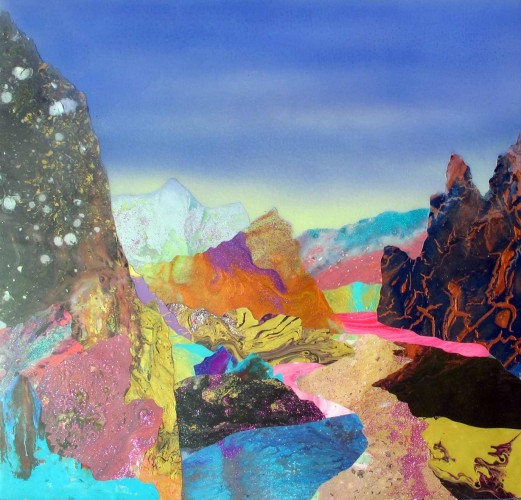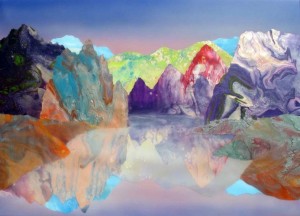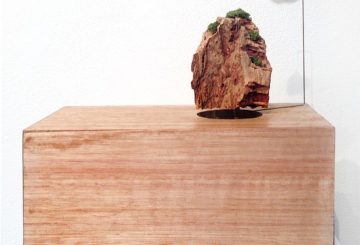Isobel Philip feels the push and pull of the sumptuous depths of Kate Shaw’s paintings…
The imaginary landscapes Kate Shaw defines in Irrational Geographic showing at Sullivan+Strumpf can throw one a little off balance. When you walk up to one of her paint collages you are coerced into a perspectival tug of war. These works simultaneously confront you with shallow depth of field and pull you into a vacuous abyss.
Acrylic and resin on board, 60 x 60cm.
These works are about the surface and the void. They are crowded and empty in the very same instant.
Shaw constructs her landscapes from fragments of poured, marbled paint. She arranges shards of dried paint in collaged compositions before applying a coat of resin. What results is palpably two-dimensional. These clusters of paint are abrupt, homogeneous forms made from clashes of lurid, seductively garish colours (with a splash of glitter here and there). They linger on the surface of the work. And yet there is depth here. There is a pull.
Shaw’s collaged forms are more figurative than abstract. Some recall rock formations and rugged outcrops while others depict the silhouettes of leafless trees. All of these forms are ungrounded. They rise up out of an abyss, a field of un-broken, un-fragmented paint. In those works where the rock formations appear to be reflected, as if an invisible pool of water divides the composition in two, the pull of the abyss is quite unnerving. There is no knowing how deep that invisible pool is.
It is easy to get lost in that abyss, just as it is in the other, hidden, voids that can be found within these ‘paintings’. In the shards of marbled paint that make up these rock formations different colours and consistencies of paint fold into one another. Paint envelops paint, as if to conceal something from the viewer.
Acrylic and resin on board, 60.5 x 91cm.
With their creases and folds each marbled paint fragment looks like the cross section of a mineral found deep beneath the earth’s surface. Once I had made this connection I began to understand just what could be concealed within the folds of that paint.
Rock time is very different to human time. While we live by minutes and hours and days and are dictated by metrical time rocks just sit. Their life span is measured in aeons, not years. The cross section of a rock, its dissection, reveals its temporal weathering. Rocks age slowly. They are marked by time.
It was the markings and depths of rock time that I saw seep out of the creases and folds of Shaw’s paint, and it was with these crevices that my eye and attention were preoccupied. I found myself constantly looking at the works so closely, my face only inches away from that layer of resin I was following the contours of the folds in the paint as if I were studying a map. This map charts, as Shaw forewarns us, an irrational geography. The landscapes exposed here are not, at least for me, spatial, but temporal. Shaw’s is a topology of time, and one whose perspective simultaneously pushes and pulls the viewer. Fitting really, when one considers how we are all pushed and pulled – held in a state of constant flux – by the rhythms of time.





Pingback: Tweets that mention Rock time | The Art Life -- Topsy.com